


Evidence suggests umbrellas originated in ancient Egypt and nearby Assyria. The earliest umbrellas or parasols were used to provide protection from the sun. These earliest umbrellas were made from palm leaves attached to sticks. According to UmbrellaHistory.net, umbrellas signified rank and nobles used the devices to keep their skin pale and untouched by the sun. In Assyria, only kings had the right to be protected by elaborate parasols.
Anyone who has been kept dry during a downpour because of umbrellas can thank the Chinese. The modern-day rain umbrella is a variation of waterproof parasols created in the 11th century BC. The earliest waterproof umbrellas were made of silk or paper that was waxed and lacquered for protection. Again, umbrellas signified a person of esteem, and the more elaborate the umbrella, the more important the person being protected by the device.
It wasn't until the 16th century that the umbrella became popularized in the western world, according to the history and invention site ThoughtCo. The word "umbrella" comes from the Latin root "umbra," meaning "shade." However, in the rainy climates of northern Europe, the waterproof umbrellas would be an asset for men and women hoping to stay dry. Persian traveler and writer Jonas Hanway popularized umbrellas through his own personal use, and men even called their umbrellas a "Hanway."
The British helped define the modern umbrella and even opened up the first shop devoted entirely to umbrellas. James Smith and Sons opened in 1830 in London, producing umbrellas made from wood or whalebone covered with alpaca or oiled canvas. Curved handles were made by hand and were genuine works of art.
Steel-ribbed umbrellas would come several years later. Collapsible umbrellas would not appear for roughly 100 years, when Hans Haupt's pocket umbrella and Bradford Phillips' modern folding mechanism in umbrellas were introduced.
Modern umbrellas continue to be perfected, with certain types folding outward rather than inward to keep errant drops at bay; umbrellas that cannot be flipped inside out; those that can withstand very strong winds; and umbrellas that open and shut easily with the push of a button. China still reigns supreme in regard to the production of umbrellas, just as it did all those centuries ago.

or register to post a comment.